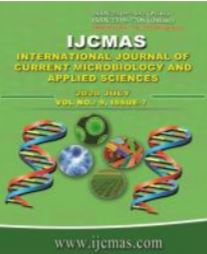


 National Academy of Agricultural Sciences (NAAS)
National Academy of Agricultural Sciences (NAAS)

|
PRINT ISSN : 2319-7692
Online ISSN : 2319-7706 Issues : 12 per year Publisher : Excellent Publishers Email : editorijcmas@gmail.com / submit@ijcmas.com Editor-in-chief: Dr.M.Prakash Index Copernicus ICV 2018: 95.39 NAAS RATING 2020: 5.38 |
The present study was carried out to characterize two newly collected Pleurotus species viz., Pleurotus djamor isolate virutha1 and Pleurotus djamor isolate woody 1 compared with Pleurotus florida which is a commercial cultivar. All these Pleurotus spp. grew well in maize agar medium compared to potato dextrose agar medium. With regard to phenotypic characters of mycelia on the culture medium, mycelial growth of P. florida appeared thick, cottony white and rhizomorphic strands as generally noticed in most of the mushroom culture. Interestingly, P. djamor isolate woody 1 appeared thin, loosely grown, non-rhizomorphic mycelia and sparingly aggregated white mycelial strands. P. djamor isolate virutha appeared intermediate mycelial type such as moderately rhizomorphic mycelial aggregation and moderately thick and white growth. With regard to mycelia growth pattern on the spawn, P. djamor isolate woody1 and P. djamor isolate virutha 1 appeared loosely interwoven, low mycelial density and non-rhizomorphic mycelial strands on the paddy/sorghum grain substrates. Whereas, P. florida appeared thick, densely grown, cottony white and rhizomorphic mycelial strands on the paddy/sorghum grain substrates. The appearance of the thin/loose filamentous mycelial pattern can be used as phenotypic marker for the identification of these two new P. djamor isolates woody1 and P. djamor isolate virutha 1.
 |
 |
 |
 |
 |